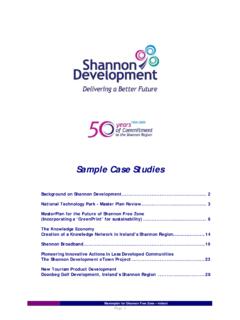Transcription of The dormouse conservation handbook - People's Trust for ...
1 Working towards Natural Englandfor people, places and natureThe dormouseconservation handbooksecond editionThe dormouse conservation handbookSecond editionbyPaul Bright, Pat Morris and Tony Mitchell-JonesIllustrated by Sarah Wroot3 The dormouse conservation handbook - second editionForeword and acknowledgements51 Introduction: dormice and issues they framework and support102 Introduction to dormouse dormouse habitats and in other with small population size183 Finding signs of dormice and monitoring the presence of evidence of surveys good practice dormice and taking population density304 Habitat woods for objectives of woodland management for conservation Woodlands for dormouse Forestry woodlands where dormice are of Plantations on Ancient Woodland Sites (PAWS) problems caused by deer and stock and their for habitat management435 Development and background and is a licence required?
2 Impacts from likely and mitigation and and compensation dormice526 Legislation, legal status & direct and and policy55 Contents47 Captive breeding and reintroduction to the and so far608 The National dormouse Monitoring Dormice at National and Regional recording schemes629 conservation achievements and UK Biodiversity Action with the national action for the next decade6410 Organisations & Department for Environment, Food and Rural of the Deputy Prime Planning and environmental Forestry Wildlife s Trust for Endangered Species and the Mammals Trust Biological Records Centres and the Mammal dormouse Captive Breeders Group (CDCBG) organisations6811 case studies in development and National Cycle Route 45 in The Severn Valley, a road junction7012 References71 Nest box suppliers73 Contentscontinued5 The dormouse conservation handbook - second editionForeword and acknowledgementsThe authors wish to express their gratitude to the many hundreds ofvolunteers who have helped with the study and monitoring of dormousepopulations over the past two decades.
3 We also acknowledge thevaluable and extensive input from the Common dormouse CaptiveBreeders Group, a number of ecological consultants, and fromrepresentatives of organisations that have been directly involved indormouse conservation , survey and mitigation work. A workshopattended by Nida Al-Fulaij, Neil Bemment, Caitriona Carlin, PaulChanin, Warren Cresswell, Fred Currie, Valerie Keeble, Roger Trout,Cathy Turtle and Michael Woods was very helpful in clarifying manyissues and identifying good practice. We are particularly grateful toRoger Trout of Forest Research for his very considerable input to thechapter on Habitat Management. This handbook is endorsed by the dormouse Focus Group (BAP group)as a contribution to the delivery of the Biodiversity Action Plan for October 2006, English Nature, Defra s Rural Development Service andthe Landscape.
4 Access and Recreation Division of the CountrysideAgency will come together to form a new agency, Natural currently provided by RDS or English Nature, such as speciesadvice and licensing, will then be provided by the new BrightPat MorrisTony Mitchell-JonesJanuary 2006 This considerably expanded second edition of the DormouseConservation handbook draws together much information onthe species that has been gathered since the first edition waspublished in 1996. In particular, the introduction of a licensingsystem for European protected species has highlighted theneed for guidance on mitigating the impact of development orother operations on dormouse populations. Mitigationstudies are still developing, but we have included, whereverpossible, good practice guidance that should help determineappropriate levels of survey and mitigation in a variety ofcircumstances.
5 Examples of successful mitigation are stillrelatively rare and we would welcome further case studies asthey become messages There is only one native species ofdormouse in Britain, whose basicbiology is very different from thatof ordinary mice . Dormice are protected by lawbecause their numbers anddistributional range have declinedby at least half during the past 100years. This decline still continuesin some regions. Dormice are important becausethey are a flagship species ; where dormice occur, the habitat is usually very suitable for a wide range of other species are also important as bioindicators as they areparticularly sensitive to habitat and population fragmentation, so their presence is an indication of habitat integrity and sustainable populations of other sensitive species.
6 Dormice normally occur in highlydiverse deciduous are also frequently found inspecies-rich hedgerows and scruband they also occur in habitats suchas gardens and conifer plantations. Dormice hibernate on or under theground from about October untilMarch or April. They are thusaffected by ground disturbance inwinter and early spring. Dormice are vulnerable towoodland and hedgerowmanagement operations. In manyareas, deer or livestock are also amajor problem, compromisingregeneration and reducing shrublayer extent and diversity. The potential presence of dormiceshould be considered whendevelopment, habitat managementor land-use change is planned thataffects any type of woodland,hedgerow or scrub. A surveyshould be carried out at the earliestpossible opportunity as mitigationmeasures may depend on theseason and may not be easilyaccommodated into workstimetables later.
7 As the dormouse is a European protectedspecies, a licence may be requiredto permit activities that wouldotherwise be illegal. English Nature strongly advisesdevelopers to seek the services of aprofessional environmentalconsultant with appropriateexperience when contemplating adevelopment proposal that mightaffect dormice, or potentialdormouse habitat. When considering applications for planning permission, planningauthorities should take account ofthe presence of dormice and otherprotected species. They mayrefuse applications where adevelopment will have adverseeffects on protected fauna or flora,or if a suitable survey to assess the impact of a development onprotected species has not beencarried out. Local authoritiesshould request applicants toinstigate such a survey beforedetermination rather than adding it afterwards as a condition ofapproval.
8 If disturbance to dormouse habitatcannot be avoided, mitigation toreduce or compensate for thisdisturbance is likely to be acondition of planning approval andmust be proportionate to theprobable impact of thedevelopment. Similar conditionsare likely to apply to a licence. Mitigation and subsequentwoodland management may haveto be carefully timed to protectdormice. Restoration of habitatcontinuity is particularly importantand should sometimes include landthat lies outside the area directlyaffected by operations. Sometimesa considerable period of time maybe necessary to carry out this work,particularly where planting isrequired that may not mature forseveral years. Arranging tomonitor the effects of mitigationand woodland management ishighly desirable, and often arequirement of planning permission Mitigation may involve thetranslocation of dormice, but thisshould be considered a last resort option because it is disruptive tonatural populations and suitablesites for releasing animals may notbe available locally.
9 Moreover,establishing translocated dormicepopulations is a complex andexpensive operation that requiresspecialist supervision. Protected species legislationapplies independently of planningpermission. Licences may benecessary for operations that do not require planning permission but do affect dormice. This document gives genericadvice on woodland management,the assessment of developmentimpacts and the creation ofmitigation plans. It does not give a comprehensive explanation ofcurrent legislation, and readers may wish to seek their own legal dormouse conservation handbook - second editionWidespread populationsScattered populations Inventory recordReintroduction siteFigure 1 dormouse distribution. Originally dormice were widespread over most of England and Wales, but they are now found only in the shaded areas.
10 Circles show records from the national dormouse inventory, collected since show sites of reintroductions carried out as part of the Biodiversity Action Plan. This map can help to predict thelikelihood of finding dormice in an dormouse conservation handbook - second edition1 Introduction: dormice and issues they raiseentirely absent from Scotland. Themost northerly location is nearHexham in Northumberland, with atleast three more sites in are now either absent orvery thinly distributed in mostmidland and many southerncounties. In Wales dormice havebeen found in a few widelyseparated areas in every countyexcept Anglesey (Jermyn,Messenger & Birks 2001).Although it is still uncommon, thedormouse appears to be relativelywidespread in southern Englishcounties but, because of itsspecialised habitat requirements, it is never as numerous as woodlandrodents such as the wood mouseApodemus sylvaticus and bank voleClethrionomys glareolus.


